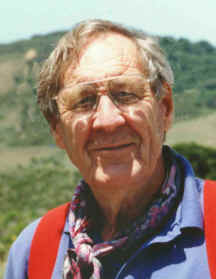Bernard I. Pietsch

Archeo-Metrologist, Author and Lecturer
With more than 50 years of independent
investigation behind him, Bernard brings a wealth of intellectual acumen to
the study of ancient art and architecture. The breadth of his survey includes
research into all manner of cyclic occurrence: biological rhythms in plants
and animals, astronomical periodicities, the dynamics of earth magnetism,
tidal phenomenon and more. “The culmination of our understanding of
the natural order,” says Pietsch “is the recognition of the pervasiveness
of the Gold Proportion. The Golden Ratio can be detected in the substructure
of all processes whether biological, physical or astronomical. It is
fundamental to all the questions regarding chaos, fractals, the unified field,
the expansion of the universe.” Mr. Pietsch addresses the questions:
“What is driving the Golden Proportion? Why is it ubiquitous?” in
several abstracts from a larger work in progress unfolding on his web site The
Philosopher’s Stone at: www.sonic.net/bernard
Most recently Mr. Pietsch’s attention has been given to exploring the
architectural remnants of lost civilizations. He notes: “It is not the
civilizations that have been lost; it is we who have lost contact with the
inner knowledge upon which those great civilizations were built. Our goal is
to re-connect with the mind of those who placed their knowledge of the
universal into the repositories of antiquity: whether it be works of art, oral
tradition, literature, architecture or the structure of music.”
Using the instruments of measure, mathematics and geometry, Bernard’s
approach to reading the great monuments is original and innovative. He has
recovered the source of ancient systems of measure, which he refers to as the
Essential Canon of Measure. The origin of this Canon he says, “is neither
culturally derived nor invented, but rather emergent. It is an amalgam
of biological, astronomical, chemical and geo-magnetic harmonics infused with
the physiological rhythms of the human body. The Essential Canon of Measure informs
the metrological systems of the ancient world.” Bernard finds
indication of its use in stone circles, dolmens, obelisks and pyramids on
every continent. By applying the Canon to the great stone monuments of
antiquity, he is able to read the intended communication of the
designer of the work.
Using the process of Archaeo-metrology, Mr. Pietsch articulates the meaning of
numerous stone works. His approach brings fresh insight to the perennial
mysteries of old. For example:
o
o
o
o
Although metrological language may elude those not conversant with
mathematics, Bernard also offers numerous physical models. He holds
himself to the challenge of being able to demonstrate a concept with an object
available “within a radius of 20 feet.” Using the tools of the Cannon of
Measure, Mr. Pietsch says anyone could read the monuments that he has decoded.
“I investigate objects upon which I can lay my tape measure…I’d rather
draw my conclusions from the stone or the art work itself, rather than appeal
to the commentaries of others.”
©Bernard I. Pietsch
email: bernard@sonic.net
website: www.sonic.net/bernard